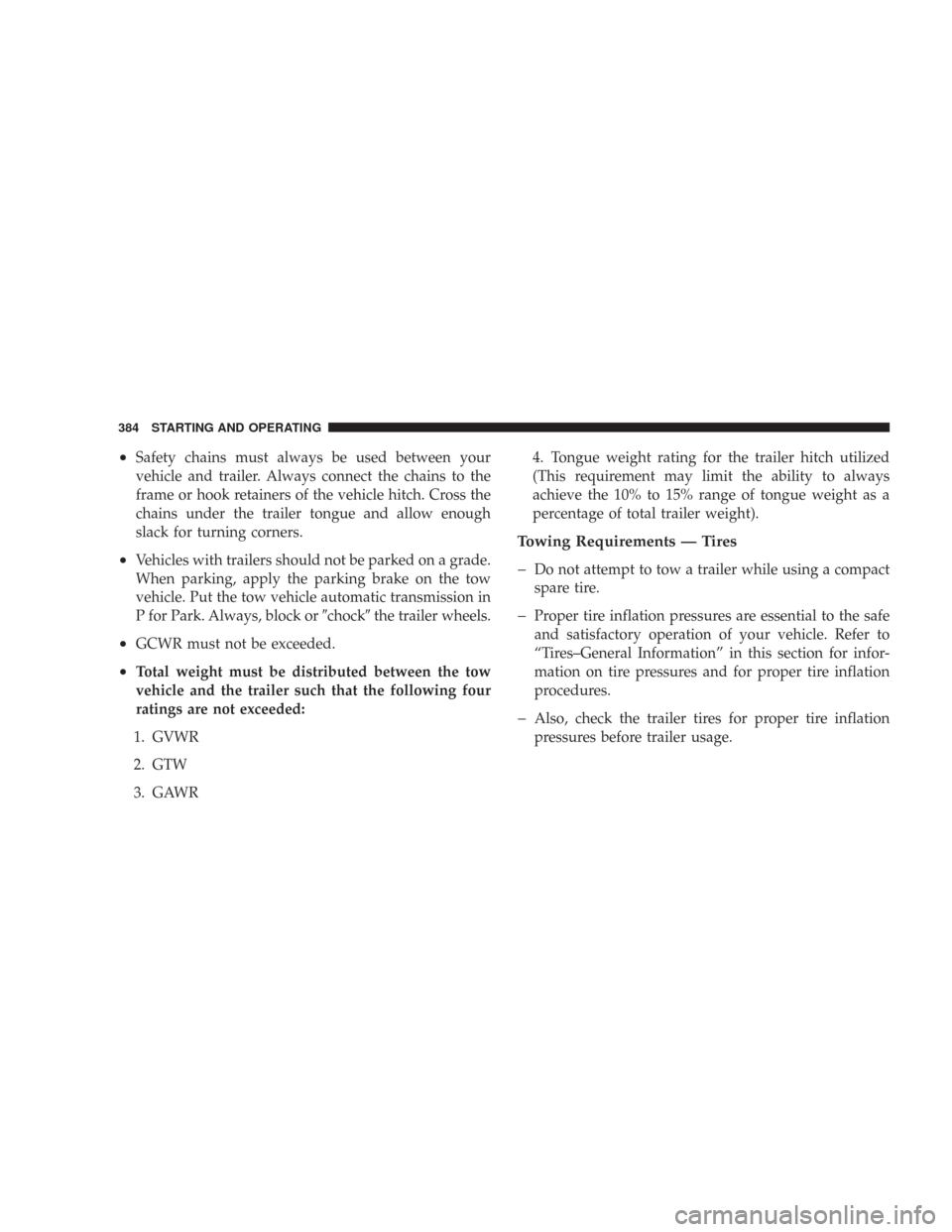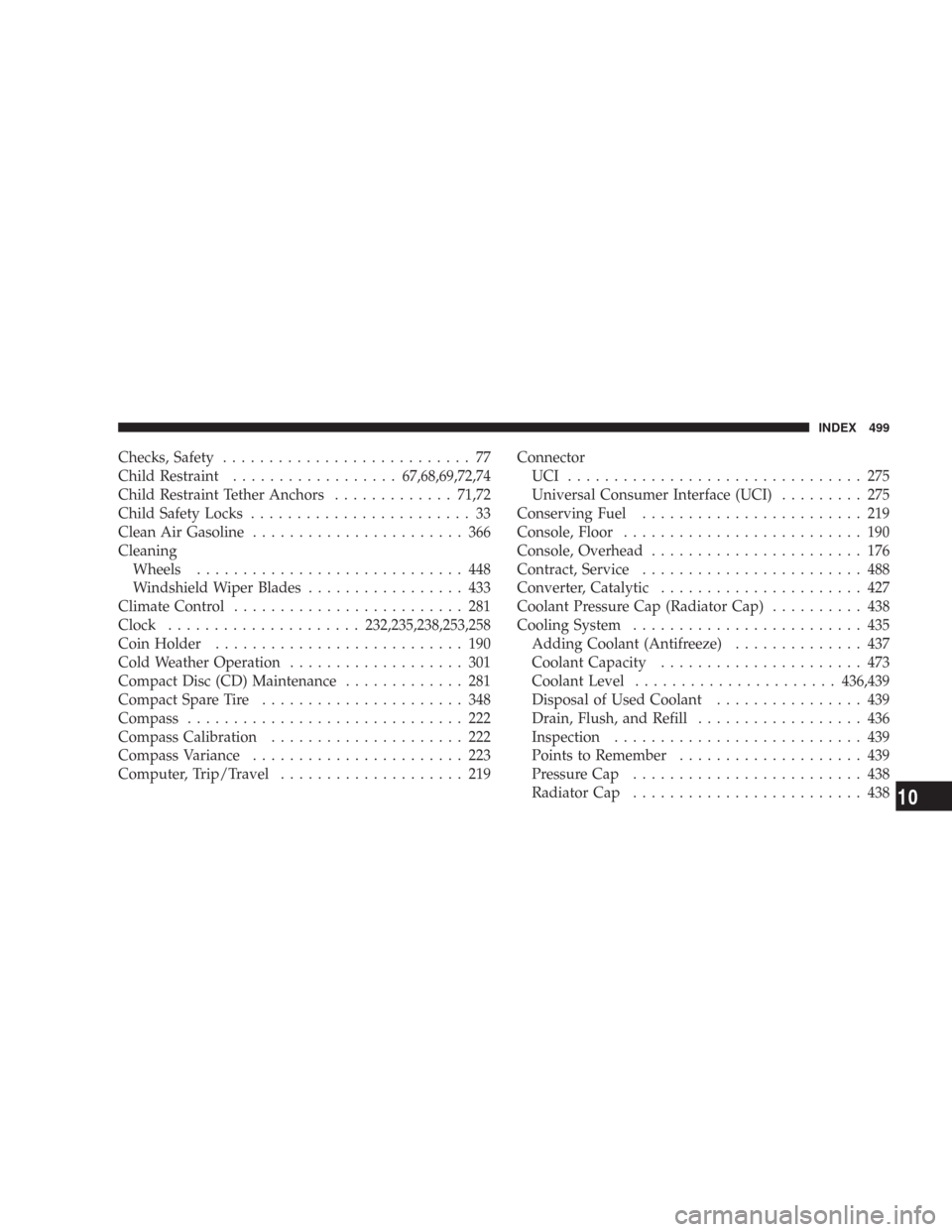Page 361 of 519

•3 Trigger Modules (mounted in three of the four
wheel-wells)
•Various Tire Pressure Monitoring System Messages,
which display in the Electronic Vehicle Information
Center (EVIC)
•Tire Pressure Monitoring Telltale Light
The matching full size spare wheel and tire assembly (if
equipped) has a tire pressure monitoring sensor. The full
size spare can be used in place of any of the four road
tires. A spare with a pressure below the low-pressure
limit will not cause the Tire Pressure Monitoring Telltale
Light to illuminate or the chime to sound.
Tire Pressure Monitoring Low Pressure Warnings
The Tire Pressure Monitoring Telltale Light will
illuminate in the instrument cluster and a chime
will sound when tire pressure is low in one or
more of the four active road tires. In addition, theElectronic Vehicle Information Center (EVIC) will display
one or more Low Pressure messages (Left Front, Left
Rear, Right Front, Right Rear) for 3 seconds and a graphic
showing the pressure values of each tire with the low tire
pressure values flashing.
Should this occur, you should stop as soon as possible,
and inflate the tires with low pressure (those flashing in
STARTING AND OPERATING 361
5
Page 363 of 519

1. Signal interference due to electronic devices or driving
next to facilities emitting the same Radio Frequencies as
the TPM sensors.
2. Installing aftermarket window tinting that contains
materials, which may block radio wave signals.
3. Accumulation of snow or ice around the wheels or
wheel housings.
4. Using tire chains on the vehicle.
5. Using wheels/tires not equipped with TPM sensors.
NOTE:
Vehicles with Full Size Spare
1. The matching full size spare wheel and tire assembly
has a tire pressure monitoring sensor that can be moni-
tored by the TPMS.
2. If you install the full size spare in place of a road tire
that has a pressure below the low-pressure warning limit,upon the next ignition key cycle, a chime will sound and
the TPM Telltale Light will turn ON. In addition, the
EVIC will display a Low Pressure message and a graphic
showing the low tire pressure value flashing.
3. After driving the vehicle for up to 10 minutes above 15
mph (25 km/h) the TPM Telltale Light will turn OFF, as
long as no tire pressure is below the low-pressure warn-
ing limit in any of the four active road tires.
NOTE:
Vehicles with Compact Spare
1. The compact spare tire does not have a tire pressure
monitoring sensor. Therefore, the TPMS will not monitor
the pressure in the compact spare tire.
2. If you install the compact spare tire in place of a road
tire that has a pressure below the low-pressure warning
limit, upon the next ignition key cycle, the TPM Telltale
STARTING AND OPERATING 363
5
Page 384 of 519

•Safety chains must always be used between your
vehicle and trailer. Always connect the chains to the
frame or hook retainers of the vehicle hitch. Cross the
chains under the trailer tongue and allow enough
slack for turning corners.
•Vehicles with trailers should not be parked on a grade.
When parking, apply the parking brake on the tow
vehicle. Put the tow vehicle automatic transmission in
P for Park. Always, block or�chock�the trailer wheels.
•GCWR must not be exceeded.
•Total weight must be distributed between the tow
vehicle and the trailer such that the following four
ratings are not exceeded:
1. GVWR
2. GTW
3. GAWR4. Tongue weight rating for the trailer hitch utilized
(This requirement may limit the ability to always
achieve the 10% to 15% range of tongue weight as a
percentage of total trailer weight).
Towing Requirements — Tires
�
Do not attempt to tow a trailer while using a compact
spare tire.
�Proper tire inflation pressures are essential to the safe
and satisfactory operation of your vehicle. Refer to
“Tires–General Information” in this section for infor-
mation on tire pressures and for proper tire inflation
procedures.
�Also, check the trailer tires for proper tire inflation
pressures before trailer usage.
384 STARTING AND OPERATING
Page 391 of 519
WHAT TO DO IN EMERGENCIES
CONTENTS
�Hazard Warning Flasher..................392
�If Your Engine Overheats.................393
�Jacking And Tire Changing................394
▫Preparations For Jacking................395
▫Jack Location/Spare Tire Stowage..........396
▫Jacking And Changing a Tire.............398
▫Compact Spare Tire....................402
▫Wheel Cover Or Center Cap Installation
(If Required).........................402�Jump-Starting Procedures.................404
�Freeing A Stuck Vehicle..................407
�Towing A Disabled Vehicle................408
▫Without The Ignition Key...............408
▫Towing This Vehicle Behind Another Vehicle
(Flat Towing With All Four Wheels On The
Ground)............................409
▫Towing This Vehicle Behind Another Vehicle
With A Tow Dolly.....................410
6
Page 398 of 519
WARNING!
A loose tire or jack thrown forward in a collision or
hard stop could endanger the occupants of the ve-
hicle. Always stow the jack parts and the spare tire in
the places provided.
Jacking and Changing a Tire
1. Block the wheel diagonally
opposite the flat tire. Passengers
should not remain in the vehicle
when the vehicle is being jacked.
2. Remove the spare tire, jack, and lug wrench.3. If equipped with steel wheels, do not remove the
wheel cover at this time. If equipped with aluminum
wheels where the center cap covers the lug nuts, use the
lug wrench to pry the center cap off carefully before
raising the vehicle.
Center Cap Removal
398 WHAT TO DO IN EMERGENCIES
Page 401 of 519

6. Raise the vehicle just enough to remove the flat tire
and install the spare tire.
WARNING!
Raising the vehicle higher than necessary can make
the vehicle less stable. It could slip off the jack and
hurt someone near it. Raise the vehicle only enough
to remove the tire.
7. Remove the lug nuts, wheel cover (if equipped), and
tire. Remove the cover by hand. Do not pry it off.
8. Mount the spare tire.
NOTE:For vehicles so equipped, do not attempt to
install a center cap or wheel cover on the compact spare.
However, when reinstalling the road tire, follow the
procedure under “Wheel Cover or Center Cap Installa-
tion” in place of the remaining steps in this procedure.9. Install the lug nuts with the cone shaped end of the
nut toward the wheel. Lightly tighten the lug nuts. To
avoid the risk of forcing the vehicle off the jack, do not
tighten the lug nuts fully until the vehicle is lowered to
the ground.
10. Lower the vehicle to the ground by turning the jack
handle counter-clockwise.
11. Finish tightening the lug nuts. Push down on the
wrench while tightening for increased leverage. Alternate
lug nuts until each nut has been tightened twice. The
correct tightness of each lug nut is 100 ft/lb. (135 N. m).
If in doubt about the correct tightness, have them
checked with a torque wrench by your dealer or at a
service station.
12. Stow the jack, tools, and flat tire. Make sure the base
of the jack faces the rear of the vehicle before tightening
down the fastener.
WHAT TO DO IN EMERGENCIES 401
6
Page 402 of 519

WARNING!
A loose tire or jack thrown forward in a collision or
hard stop could endanger the occupants of the ve-
hicle. Always stow the jack parts and the spare tire in
the places provided.
Compact Spare Tire
The compact spare tire is for temporary emergency use
with radial tires. It is engineered to be used on your style
vehicle only. Since this tire has limited tread life, the
original tire should be repaired (or replaced) and rein-
stalled at the first opportunity.
•Keep tire inflated to 60 PSI (414 KPa) Cold Inflation
Pressure.
•This tire is designed as an emergency spare only. Do
not exceed 50 MPH (80 km/h) speed.
WARNING!
The limited use spare tires are for emergency use
only. Installation of this limited use spare tire affects
vehicle handling. With this tire, do not drive more
than 60 mph (100 km/h). Keep inflated to the cold tire
inflation pressure listed on either your tire placard or
limited use spare tire and wheel assembly. Replace
(or repair) the original tire at the first opportunity
and reinstall it on your vehicle. Failure to do so could
result in loss of vehicle control.
Wheel Cover or Center Cap Installation (If
Required)
NOTE:Do not attempt to install a center cap or wheel
cover on the compact spare.
402 WHAT TO DO IN EMERGENCIES
Page 499 of 519

Checks, Safety........................... 77
Child Restraint..................67,68,69,72,74
Child Restraint Tether Anchors.............71,72
Child Safety Locks........................ 33
Clean Air Gasoline....................... 366
Cleaning
Wheels............................. 448
Windshield Wiper Blades................. 433
Climate Control......................... 281
Clock.....................232,235,238,253,258
Coin Holder........................... 190
Cold Weather Operation................... 301
Compact Disc (CD) Maintenance............. 281
Compact Spare Tire...................... 348
Compass.............................. 222
Compass Calibration..................... 222
Compass Variance....................... 223
Computer, Trip/Travel.................... 219Connector
UCI ................................ 275
Universal Consumer Interface (UCI)......... 275
Conserving Fuel........................ 219
Console, Floor.......................... 190
Console, Overhead....................... 176
Contract, Service........................ 488
Converter, Catalytic...................... 427
Coolant Pressure Cap (Radiator Cap).......... 438
Cooling System......................... 435
Adding Coolant (Antifreeze).............. 437
Coolant Capacity...................... 473
Coolant Level......................436,439
Disposal of Used Coolant................ 439
Drain, Flush, and Refill.................. 436
Inspection........................... 439
Points to Remember.................... 439
Pressure Cap......................... 438
Radiator Cap......................... 438
INDEX 499
10